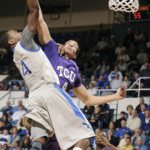Have you ever found yourself wondering just how long a basketball game lasts? Whether you’re a die-hard fan planning your day around a match or a newcomer trying to understand the game’s flow, the duration of a basketball game is an intriguing subject. With various factors influencing the length of the game, from league rules to timeouts and halftime breaks, this article will guide you through the typical basketball game timeline, keeping you well-informed and ready for the next tip-off.
Professional Basketball Game Duration
The duration of a professional basketball game is a subject of much intrigue for many fans. Unlike other sports, basketball has a unique structure that determines how long a game lasts. A standard professional basketball game in leagues like the NBA consists of four quarters, each lasting 12 minutes. However, the actual game duration extends much beyond this due to various factors such as the clock stopping for fouls, free throws, and timeouts. Each team is allowed seven timeouts during the game, and each timeout lasts 75 seconds. Moreover, under the NBA’s rules, media timeouts are also included, further extending the game duration.
Halftime in a professional basketball game provides a 15-minute break, allowing teams to rest and strategize for the remaining half. Additionally, if the game is tied at the end of the fourth quarter, overtime periods of 5 minutes are played until a winner is determined. Overtime also includes timeouts and can significantly extend the total game time. Considering these stoppages, a typical NBA game can last approximately 2 to 2.5 hours. However, tightly contested games or those with numerous fouls and free throws can extend much beyond this average duration.
Understanding the timing rules is crucial for both players and fans as it influences game strategy and viewing plans. The dynamic nature of basketball means that every second counts, and managing the clock effectively can be the difference between winning and losing. The table below summarizes the essential timing components of a professional basketball game.
| Component | Duration | Additional Notes |
|---|---|---|
| Quarters | 12 minutes | 4 quarters per game |
| Halftime | 15 minutes | Between 2nd and 3rd quarter |
| Timeouts (Team) | 75 seconds | 7 timeouts per team |
| Media Timeouts | Varies | Automatically applied |
| Overtime | 5 minutes | Additional periods as needed |
Understanding the Duration of a Basketball Game
The length of a basketball game can often seem like a mystery to the uninitiated, primarily due to variations across different leagues and levels of play. At its core, a standard professional basketball game under the National Basketball Association (NBA) guidelines consists of four quarters, each lasting 12 minutes. However, the actual duration extends beyond these 48 minutes of game time due to various factors such as the halftime break, timeouts, and the clock stopping for free throws and other interruptions. Typically, an NBA game lasts around 2 to 2.5 hours when including these stoppages.
Contrastingly, college basketball games in the United States adhere to a slightly different format, consisting of two 20-minute halves. This distinction significantly impacts the flow and length of the game, often resulting in a shorter overall duration compared to professional matches. Moreover, the frequency and length of timeouts, as well as the rules regarding the stoppage of the clock, differ between the NBA and college basketball, further contributing to the variance in game length.
In addition to these structured durations, several external factors can extend the length of a game. Overtime periods, which are 5 minutes each in the NBA, come into play if the score is tied at the end of the fourth quarter. The number of fouls, reviews of officials’ decisions, and even the pace at which a particular game is played can all influence the total time it takes to complete a basketball game. Understanding these elements is crucial for fans and participants alike to appreciate the intricacies and flow of the sport fully.
- NBA Regular Game Time: 4 Quarters of 12 Minutes Each
- College Basketball Game Time: 2 Halves of 20 Minutes Each
- Halftime Duration: Typically 15 Minutes
- Overtime Periods: 5 Minutes Each in the NBA
- Additional Factors: Timeouts, Fouls, Official Reviews
College Basketball: Time Regulations
Understanding the time regulations in college basketball is pivotal for both fans and players alike. The game is distinctly structured around two halves, each lasting 20 minutes, making the total playing time 40 minutes. This differs from the NBA’s format, which comprises four quarters, each 12 minutes long. The college game’s more concise halves contribute to a faster-paced game, demanding higher stamina and strategic planning from the teams. However, the actual duration of a college basketball game extends beyond these 40 minutes due to various factors.
One significant element that affects game length is the clock stoppage. The clock stops for several reasons, including timeouts, fouls, and the ball going out of play. Each team is allowed a set number of timeouts, and their usage strategically can influence the game’s flow and duration. Furthermore, the last minute of each half in college basketball can considerably extend due to frequent fouls and timeouts, as teams strive to capitalize on every last second. These stoppages contribute to the average college basketball game lasting approximately 2 hours.
Another factor to consider is the halftime interval, which lasts 15 minutes in college basketball. This break allows teams to rest, strategize, and adjust their game plans based on the first half’s performance. Additionally, college games may include overtime periods if the score is tied at the end of regulation time. Each overtime period lasts 5 minutes, with no limit to how many overtime periods can be played until a winner is determined. This potential for multiple overtimes adds another layer of unpredictability to the game’s length.
- Two 20-minute halves make up the regulation time, totaling 40 minutes of gameplay.
- The clock stops for timeouts, fouls, and when the ball goes out of play, extending the game’s duration.
- Each team has a set number of timeouts, and their strategic use can affect the game’s flow and length.
- The halftime interval lasts 15 minutes, providing a necessary break for rest and strategy adjustments.
- Overtime periods are 5 minutes each and continue until a winner is decided, potentially lengthening the game significantly.
By examining these aspects, one gains a comprehensive understanding of the time regulations in college basketball. While the base playing time is set at 40 minutes, the actual game duration can vary significantly due to stoppages, halftime, and potential overtimes. This variability adds to the excitement and unpredictability of college basketball, making it a beloved sport among enthusiasts and players alike.
High School Games: Length Differences
The duration of high school basketball games often varies significantly from one region to another, a reflection of differing regulations set by state high school athletic associations. Typically, a high school basketball game is divided into four quarters. However, the length of these quarters can range from six to eight minutes, unlike the standardized periods observed in college and professional basketball. This variability influences not just the pace and strategy of the game but also its duration, including the halftime break and potential overtime periods.
In addition to quarter lengths, the approach to overtime also introduces a difference in game length at the high school level. While college basketball games have a five-minute overtime period, high school overtime periods are usually four minutes, though this too can vary. The method of stopping the clock, especially in the final minutes of the game, can also extend the actual time it takes to conclude a match. Thus, while the structured game time might suggest a concise duration, the real-time experience can be significantly longer.
Another factor contributing to the difference in game lengths is the halftime break. High school basketball typically features a 10-minute halftime, although this can be shorter or longer depending on the specific rules of a state’s athletic association. The combination of these factors means that the total duration of a high school basketball game can range widely, typically anywhere from 1 hour and 15 minutes to nearly 2 hours when including pauses in play, timeouts, and intermissions.
Additional Insights on High School Basketball Game Lengths
Understanding the nuances of high school basketball game lengths requires a closer look at how these games are structured beyond just quarter lengths and halftime breaks. Factors such as the number of timeouts allowed per team, the speed of play enforced by referees, and even the level of competition can all influence the overall duration of a game. For instance, games that are closely contested may see more strategic use of timeouts in the fourth quarter, effectively elongating the game’s conclusion. Similarly, postseason and tournament games often have additional rules that can extend the length of a game, including longer overtime periods or extended halftimes for ceremonies or presentations.
| State | Quarter Length | Overtime Period Length |
|---|---|---|
| New York | 8 minutes | 4 minutes |
| California | 8 minutes | 4 minutes |
| Texas | 8 minutes | 4 minutes |
| Florida | 8 minutes | 4 minutes |
| Illinois | 8 minutes | 4 minutes |
Further Context on Game Lengths in High School Basketball
Delving deeper into high school basketball game lengths, it becomes apparent that the experience of players, coaches, and spectators is shaped by a blend of structured rules and the dynamic nature of the sport. The excitement of a close game can turn the final minute of play into a drawn-out battle of strategy and skill, where every second counts. Conversely, games with a significant lead may see a faster conclusion with the use of continuous clocks. These aspects underscore the complexity of determining an exact duration for high school basketball games, making each game a unique experience.
Variations in International Play
The duration and structure of basketball games can significantly vary when looking at the international landscape. Unlike the NBA, which follows a standardized format, international games adhere to the rules set by the International Basketball Federation (FIBA). One of the most notable differences is the game length. FIBA-sanctioned games are shorter, consisting of four 10-minute quarters, compared to the NBA’s 12-minute quarters. This difference not only affects the total game time but also impacts the pace and strategy of the game.
Another aspect where international play diverges is the halftime break. FIBA mandates a 15-minute interval, slightly less than the NBA’s 15-minute halftime. Moreover, the shot clock in international games is set at 24 seconds, mirroring the NBA, but the way it resets differs. Following an offensive rebound, the shot clock resets to 14 seconds in FIBA games, aiming to encourage a faster pace of play. The nuances in rules and game duration contribute to a distinct style of play, emphasizing speed, efficiency, and tactical prowess across different international competitions.
Additionally, the overtime periods in international basketball add another layer of variation. Each overtime lasts for 5 minutes, akin to the NBA, but the approach to fouls and timeouts can significantly influence the game’s outcome. These differences underscore the importance of adaptability and strategic planning for teams competing on the international stage. Understanding the specific rules and structure of international basketball is crucial for players, coaches, and fans alike to fully appreciate the global nuances of the game.
- Game Length: FIBA games consist of four 10-minute quarters.
- Halftime Duration: FIBA mandates a 15-minute halftime break.
- Shot Clock: Set at 24 seconds, with a reset to 14 seconds after an offensive rebound.
- Overtime: Each overtime period lasts for 5 minutes in both FIBA and NBA games.
- Strategic Differences: Variations in game rules influence the pace and strategy of international play.
Impact of Timeouts and Halftimes
The duration of a basketball game extends beyond the mere ticking of the game clock. Timeouts and halftimes play a pivotal role in determining the actual length of a game. Each professional basketball game is divided into four quarters, interspersed with a halftime break and allowed timeouts, which teams can use for strategic discussions and rest. The NBA grants a 15-minute halftime interval, significantly impacting the total game time. Additionally, each team is allocated several timeouts throughout the game, each lasting about one minute in the NBA, but this duration can vary in other leagues.
Timeouts, while brief, are crucial for teams to regroup, plan strategies, and make quick adjustments. The number of timeouts and their length can add a considerable amount of time to the game clock, especially in close matches where strategic use of timeouts is paramount. Moreover, the end of quarters and the game itself often sees an increased frequency of timeouts as teams strive to secure their position or overturn the game’s outcome. These stoppages contribute to the total duration of the game, making it longer than the initially allocated time for actual play.
Halftimes offer teams a longer break to recover, but they also serve as an opportunity for coaching staff to provide in-depth analysis and strategic adjustments based on the first half’s performance. This break is essential for maintaining the intensity and quality of the game, allowing players to perform at their best throughout the four quarters.
| Component | Duration | Impact on Game Length |
|---|---|---|
| Quarters | 12 minutes (NBA) | Core game time |
| Halftime | 15 minutes | Extended break, strategy adjustment |
| Timeouts | 1 minute each (approx.) | Strategic stops, can extend game significantly |
| Overtime | 5 minutes | Extra playtime in case of a tie |
| Total Game Time (excluding OT and timeouts) | 48 minutes | Baseline duration without stoppages |
Understanding the impact of timeouts and halftimes is crucial for fans and players alike. These elements add depth to the game, allowing for strategic nuances and ensuring players can compete at high levels throughout. While they extend the length of the game, they are integral to the sport’s competitive nature, making basketball a thrilling spectacle for its audience.
Overtime Rules Across Leagues
Overtime in basketball is the thrilling extension of a game that occurs when the score is tied at the end of regulation time. While the fundamental concept of overtime is consistent across various basketball leagues, the specific rules and duration can vary significantly. This diversity adds a layer of complexity and excitement to the game, influencing team strategies and fan expectations.
In the NBA, overtime periods last for 5 minutes, with no limit to the number of overtime periods that can be played until a winner is determined. This rule keeps the game highly competitive and unpredictable, ensuring a fair chance for both teams to clinch victory. On the other hand, the NCAA (college basketball) also adopts a 5-minute overtime period but differs in its approach to fouls and time-outs, directly impacting the game’s pace and strategy. International basketball, governed by FIBA, follows a similar 5-minute extension but with its unique set of regulations concerning fouls and player substitutions.
Differences in overtime rules are not merely a matter of time but also involve intricacies such as the number of time-outs allowed, foul limits, and the possession arrow, which can significantly influence the outcome of the game. These variations necessitate that teams and coaches be adaptable and well-versed in the specific regulations of their leagues to devise effective game plans for potential overtime scenarios.
- NBA: 5-minute periods, unlimited extensions
- NCAA: 5-minute periods, specific foul and time-out rules
- FIBA: 5-minute periods, unique substitution and foul regulations
- WNBA: Similar to NBA but with distinct strategies for female athletes
- High School: Varies by state, often shorter periods with distinct rules
The Role of Clock Stoppages
Clock stoppages play a crucial role in determining the actual length of a basketball game. Unlike the continuous clock seen in some sports, basketball features a series of stoppages that can significantly extend the duration of a game beyond its official playing time. These stoppages occur for various reasons, including fouls, ball out-of-bounds, timeouts, and the review of certain plays by officials. Understanding these stoppages is essential for both players and fans to grasp the flow and timing of the game.
One of the most significant aspects of clock stoppages is their impact on strategy. Coaches and players use timeouts strategically to rest their players, plan plays, or disrupt the momentum of the opposing team. Additionally, the final minutes of a basketball game can be elongated due to the frequent stoppages, as teams commit fouls to regain possession of the ball or stop the clock. This part of the game, often referred to as “garbage time,” can add a considerable amount of time to the clock.
Moreover, the advent of instant replay reviews in basketball has added another layer to clock stoppages. Officials can now review certain plays in the final minutes of the game, which, while ensuring the accuracy of critical calls, also adds to the overall length of the game.
Understanding the Impact of Timeouts and Reviews
Delving deeper into the role of clock stoppages, it’s clear that timeouts and official reviews stand as pivotal elements that affect not just the duration but the very nature of the game. Timeouts, both team and media, offer strategic advantages but also introduce additional stoppages that extend game time. Reviews, on the other hand, ensure game integrity but at the cost of game flow and duration. Balancing these elements is a constant challenge for the governing bodies of basketball.
| Stoppages Type | Reason | Average Duration |
|---|---|---|
| Timeouts | Strategy/Rest | 1 minute |
| Fouls | Rule Infractions | Variable |
| Reviews | Play Verification | 2 minutes |
| Out-of-Bounds | Ball Leaves Play | Variable |
| Media Timeouts | Commercial Breaks | 2-3 minutes |
In conclusion, clock stoppages are an integral part of basketball, deeply influencing game length and strategy. While they can extend the duration of a game, they also add a layer of tactical depth that enriches the sport. As basketball continues to evolve, the rules and usage of clock stoppages will undoubtedly adapt, continuing to shape the game in new and exciting ways.






